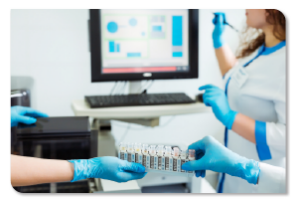It is widely recognized within the healthcare industry that most of the data used to make medical decisions and develop treatment plans comes from the laboratory. Because the laboratory holds such a large volume of patient data, that information can be analyzed for both internal laboratory insights as well as external metrics that impact the entire organization. Combining lab data and other healthcare data for analysis can uncover valuable information and provide insights that can help guide a healthcare organization’s business decisions and have a positive impact on patient care and finances.
Executive Summary
- Most of the data used to make medical decisions and develop treatment plans comes from the laboratory.
- Laboratories can use their data to track internal key performance indicators (KPIs) and test utilization as part of a larger laboratory stewardship program that promotes laboratory productivity and increases the laboratory’s contribution to the best patient care.
- Laboratory data combined with other healthcare data can be used to guide organization-wide decisions in matters of patient care and spending.
Overall Value of Laboratory Data
Laboratory testing is healthcare’s highest-volume activity, estimated at 13 billion tests per year in the U.S.1 Laboratory testing provides tremendous value to our healthcare system—for public health, diagnosis, treatment, chronic disease management, personalized medicine, preventive medicine, and much more. Providers use laboratory test results for screening,  diagnosis, and disease monitoring. Two thirds of test results contribute to a change in diagnosis, therapy, prognosis, or the understanding of disease.2
diagnosis, and disease monitoring. Two thirds of test results contribute to a change in diagnosis, therapy, prognosis, or the understanding of disease.2
With the knowledge that early diagnosis and intervention reduces overall healthcare costs, laboratory diagnostics also plays a key role in population health management and the screening of healthy patients.
In addition to the overall value of laboratory testing to patient care, laboratories amass significant data sets that can be analyzed to establish key insights, both internally and organization-wide, that can guide business decisions and uncover opportunities for cost savings.
Internal Laboratory Analytics Support Best Practices
Laboratory data can be mined and analyzed to gain efficiencies in areas of test turnaround time (TAT), test utilization, inspection preparedness, and staffing, culminating in comprehensive laboratory stewardship and staffing productivity.
The Value of Laboratory Utilization Tracking
Laboratory results make a substantial contribution to critical care decisions. Therefore, it is important to have the most appropriate tests ordered to ensure the best patient care. Tracking lab test utilization can find areas of overuse, underuse, and misuse. Laboratories can pair their utilization data with evidence-based guidelines to uncover areas of overutilization or underutilization and guide best test ordering.
Test utilization monitoring has the potential to save the healthcare system millions of dollars in unnecessary lab testing costs. On an annual basis, inappropriate lab test orders cost the U.S. healthcare system up to $200 billion.3 According to the Institute of Medicine, unnecessary lab tests cost an average hospital $1.7 million a year. With data analytics, laboratory managers can independently generate reports to identify sources of unnecessary testing. Laboratory test utilization reports illustrate the laboratory’s data in a way that identifies unnecessary testing and helps laboratory management locate the areas of greatest opportunity for corrective action.
It is often assumed that overutilization involves too much repeat testing. However, inpatient standing orders are often the cause of overutilization. A study at the University of California, San Francisco Medical Center, revealed that reducing five common lab tests by nearly 50% had no effect on patient care or safety. The study determined that, “No clinical decisions were made based on those lab results, whether they were normal or not. The patient’s care would not have changed at all whether we had done that test or not.” Savings by not performing these unnecessary tests were $2 million, including $75,000 in direct costs for their medical center.4
With the goal of proper lab test utilization, underutilization is also a consideration. By implementing early chronic disease care through increased use of diagnostic lab services, significant healthcare spending can be avoided. Laboratory testing plays a pivotal role in identifying and tracking chronic conditions to help clinicians create appropriate treatment plans.
Test Formularies & Reflex Algorithms
 With a laboratory formulary, laboratory professionals and pathologists can play the role of gatekeeper and manage their test menu appropriately, contributing their expertise to help advise the best test orders. A formulary can be used to identify tests that require laboratory intervention and review.
With a laboratory formulary, laboratory professionals and pathologists can play the role of gatekeeper and manage their test menu appropriately, contributing their expertise to help advise the best test orders. A formulary can be used to identify tests that require laboratory intervention and review.
Proper implementation of testing algorithms that cascade through a logical testing sequence based on initial results can be developed in tandem with ordering physicians. For providers, this can help pare down the overwhelming menu of hundreds of available tests to only the relevant tests. These algorithms are instrumental in making sure that only the appropriate tests are ordered. Laboratory-driven algorithms allow the laboratory to handle the entire cascade or algorithm process with no further input from the provider.
Laboratory Stewardship
The concept of laboratory stewardship takes the lab formulary to the next level. A laboratory stewardship program focuses on making sure the best tests are ordered as well as properly interpreted. Laboratories have always focused on efficiency; however, true laboratory medicine includes involvement in downstream healthcare processes related to lab testing.5 This creates an opportunity for laboratorians to become actively involved with providers in determining best test selection, performance, and interpretation. Laboratory stewardship means the laboratory takes responsibility for and remains active in its use of lab testing, from order through interpretation to
analytics. Key elements include governance, interventions, data extraction and monitoring,
and ongoing improvement strategies.6
Data-driven Lab Scheduling Helps Address Staffing Shortages
 Laboratories can track testing volumes and TATs to adjust staffing schedules. Lab utilization data can be used to make staffing decisions that allow employee schedules to correspond with testing volumes. Data analysis can answer questions like:
Laboratories can track testing volumes and TATs to adjust staffing schedules. Lab utilization data can be used to make staffing decisions that allow employee schedules to correspond with testing volumes. Data analysis can answer questions like:
- How many of each test does each lab specialty area perform daily?
- How long does each test and/or task take an employee to complete?
Managers can closely predict how many technologists are needed in each lab area for each shift, resulting in greater efficiency and perhaps enabling creative scheduling that boosts employee satisfaction. Managers can see patterns then staff their laboratory according to peak times to
keep up with TAT goals.
Employee performance can be benchmarked against averages. Technologist throughput can be measured to identify top performers and evaluate their methods to improve process efficiency.
Best practices can be determined and included as part of training to improve overall lab productivity.
Benchmarking for Continuous Quality Improvement
Benchmarking is a tool that measures performance against a target to improve performance. Benchmarking of clinical laboratory activities enables administrators to evaluate lab performance and identify opportunities for improvement, also providing an opportunity to improve stewardship activities. Critical aspects of any benchmarking application include the ability to measure changes in performance over time, to recognize trends, and to measure progress toward the achievement of targets set by the initial benchmarks.
Best practice benchmarking is particularly relevant for clinical laboratory stewardship, where processes and best practices are identified to establish target improvement goals. Performance is measured against the target after the best practices have been implemented.
Nonconformities and complaints are also important metrics for evaluating the quality of laboratory processes. Problems or nonconforming events are tracked and monitored so that solutions can be implemented. Laboratories should document events, monitor for trends, and investigate to identify the root cause of problems.
Internal Lab Analytics in Action
Provider Variation Analysis Savings at Crystal Run
 Crystal Run Healthcare, a multi-specialty group practice in Middletown, New York, closely examined their provider ordering patterns to achieve significant cost savings. In collaboration with ordering providers, their laboratory analyzed provider variation data for specific diagnoses and used the data to standardize care and reduce costs while still maintaining high levels of quality. This led to the implementation of best-practice guidelines for common chronic diseases and preventive services.
Crystal Run Healthcare, a multi-specialty group practice in Middletown, New York, closely examined their provider ordering patterns to achieve significant cost savings. In collaboration with ordering providers, their laboratory analyzed provider variation data for specific diagnoses and used the data to standardize care and reduce costs while still maintaining high levels of quality. This led to the implementation of best-practice guidelines for common chronic diseases and preventive services.
After several months of following best-practice guidelines for ordering lab tests on patients with diabetes, Crystal Run saw a 9% reduction in the overall cost of care and a 15% reduction in lab costs. Dr. Scott Hines, Co-Chief Clinical Transformation Officer at Crystal Run, said, “What we found is that by adopting and circulating best-practice standards, physicians ordered less tests while maintaining quality. Some physicians could even argue that quality was improved and cost was reduced. That’s the real bottom line to accountable care—best quality, best patient experience, and at the lowest possible costs.”7
Test Utilization Savings at Broward Health
 Leo Serrano, FACHE, DLM (ASCP), from Broward Health in Fort Lauderdale, Florida, shared that their laboratory successfully saved more than $870,000 (annualized) by monitoring test utilization. They put in place a combination of computerized provider order entry, test formularies, and testing algorithms. At Broward, because clinicians have competition for their time, they welcomed assistance from the lab to guide them through the lab testing options. Broward Health’s success story is one of cost savings, teamwork, increased efficiency, and better patient care.8
Leo Serrano, FACHE, DLM (ASCP), from Broward Health in Fort Lauderdale, Florida, shared that their laboratory successfully saved more than $870,000 (annualized) by monitoring test utilization. They put in place a combination of computerized provider order entry, test formularies, and testing algorithms. At Broward, because clinicians have competition for their time, they welcomed assistance from the lab to guide them through the lab testing options. Broward Health’s success story is one of cost savings, teamwork, increased efficiency, and better patient care.8
Duplicate Testing Alerts at the University of Mississippi
 At the University of Mississippi Medical Center, to reduce unnecessary testing, Brad Brimhall, MD, PhD, and team implemented a duplicate testing alert in the EHR. Initially, they monitored basic metabolic panels and complete blood counts (CBCs) with the alert set to trigger when the same tests were ordered within a four-hour window. The alert notified the ordering provider of the duplicate test and asked if he or she would like to continue the order.
At the University of Mississippi Medical Center, to reduce unnecessary testing, Brad Brimhall, MD, PhD, and team implemented a duplicate testing alert in the EHR. Initially, they monitored basic metabolic panels and complete blood counts (CBCs) with the alert set to trigger when the same tests were ordered within a four-hour window. The alert notified the ordering provider of the duplicate test and asked if he or she would like to continue the order.
By implementing this one change and providing this information to the provider at the time of order—for only two tests—they were able to save an annualized total of more than $146,000.
Lab Data for External Analytics Can Improve Patient Care
With the proper infrastructure, laboratory, financial, administrative, and other healthcare data
can be combined and analyzed for insights that improve patient care and uncover opportunities
to lower costs.
Population Health Management
Laboratory data is tremendously powerful for patient risk stratification as part of population health initiatives. Information from the lab, combined with other clinical and financial data sets, can offer insights into ways that care coordinators can proactively reach out to patients to provide services that keep patients healthy and help them manage their chronic conditions.
Extending Lab Data Analysis Beyond the Lab
Ochsner Health System’s Lab Stewardship Solves Problems
 The laboratory at Ochsner Health System used the principles of laboratory stewardship to address the collection tube shortage brought on by the COVID-19 pandemic. By analyzing data from their EHR and LIS alongside evidence-based recommendations, they tracked and quantified specific tube usage and found interventions that helped alleviate the issue (e.g., eliminated collection of extra tubes and implemented evidence-based recommendations for test orders to reduce unnecessary testing).10
The laboratory at Ochsner Health System used the principles of laboratory stewardship to address the collection tube shortage brought on by the COVID-19 pandemic. By analyzing data from their EHR and LIS alongside evidence-based recommendations, they tracked and quantified specific tube usage and found interventions that helped alleviate the issue (e.g., eliminated collection of extra tubes and implemented evidence-based recommendations for test orders to reduce unnecessary testing).10
PeaceHealth Labs Provides Predictive Analytics for Population Health
PeaceHealth Labs used their hemoglobin A1C results to find patients who needed follow-up as part of their organization’s population health initiatives. They used lab data and other patient data to identify high-risk patients and care gaps. The information gleaned was used to support targeted interventions and care management and improve clinical well-being of patients with specific diagnoses. Their population health initiatives helped lower financial risk while improving clinical outcomes.11
Improving Patient Satisfaction at the University of Mississippi
The University of Mississippi Medical Center solved a patient satisfaction issue by combining and analyzing lab and imaging data. In this project, the imaging department was experiencing delays getting creatinine results for pre-contrast imaging because the lab was not located in the same building as the imaging department. This caused delays, and patients were walking out without getting their imaging study. Not only was this a patient satisfaction problem, but also a safety concern because patients were not getting the treatments they needed in a timely manner. To address this problem and improve provider and patient satisfaction, point-of-care creatinine testing was implemented in the radiology department, resulting in greater revenue because more imaging studies could be performed.12
Looking to the Future – Analytics & AI
Innovative technologies using artificial intelligence and machine learning (AI/ML) are creating opportunities for laboratory data to be used in evidence-based medicine and personalized therapies. To gain traction in this area and fully leverage healthcare data, the healthcare community will need to adopt analytics tools and incentivize interoperable data sharing between organizations.13
Leveraging Lab Data for Valuable Insights
The laboratory holds a massive amount of clinical data that feeds diagnostic decision making. As gatekeepers of the data that drives patient care decisions, laboratory leaders are encouraged to become active participants in the way lab information is used. Wider implementation of clinical laboratory analytics applications and software that are capable of integrating data will help laboratories best use their data and assist in the move to an interoperable healthcare system. Laboratories can leverage analytic tools to collect, analyze, and present data in visually meaningful ways. The future of predictive analytics in the laboratory is at its early stages and primed for endless possibilities.
Orchard Software Offers Orchard Insights
Orchard® Insights™ is a business intelligence and analytics tool focused specifically on leveraging and analyzing the tremendous amount of data that laboratories manage. The solution provides quick access to analyzed data that offers insights to aid in overall lab productivity, efficiency, and inspection-preparedness. Laboratories can use their data to track internal KPIs and test utilization as part of a larger laboratory stewardship program that guides business decisions and increases the lab’s contribution to patient care improvements. Orchard Insights gives labs the advantage of an analytic perspective that can be used to help address the industry staffing shortage and improve overall laboratory productivity and efficiency.
References
- Thorpe A, et. al. The Healthcare Diagnostics Value Game. KPMG International. https://assets.kpmg/content/dam/kpmg/xx/pdf/2018/07/the-healthcare-diagnostics-value-game.pdf. Published 2018.
- Wertman BG, et. al. Why do physicians order laboratory tests? A study of laboratory test request and use patterns. JAMA. 1980;243(20):2080–2082. doi:10.1001/jama.1980.03300460054033.
- Kaiser Health News. Unnecessary medical tests, treatments cost $200 billion annually, cause harm. https://www.healthcarefinancenews.com/news/unnecessary-medical-tests-treatments-cost-200-billion-annually-cause-harm. Published 2017.
- Commins J. Residents save $2M by eliminating needless lab tests. healthleadersmedia.com/page-1/HEP-297529/Residents-Save-2M-By-Eliminating-Needless-Lab-Tests. Published October 2013.
- Schmidt RL, Ashwood ER. Laboratory medicine and value-based health care. AJCP. 2015;144(3):357–358. https://doi.org/10.1309/AJCPWTDAJGMYLN51.
- Dickerson J, Jackson B. Improving quality while reducing costs: The art of laboratory stewardship. https://www.aacc.org/publications/cln/articles/2017/october/improving-quality-while-reducing-costs–the-art-of-laboratory-stewardship. Published October 1, 2017.
- Futrell K. The lab’s role in the ACO. ADVANCE for Administrators of the Laboratory. Published January 2013.
- Serrano L. Combining Test Formularies, Algorithms, and CPOE to Significantly Reduce Lab Test Utilization. http://www.labqualityconfab.com/wp-content/uploads/Serrano.Combining-Test-Formularies.pdf. Lab Quality Confab. Published 2013.
- ARUP Laboratories. What the c-suite doesn’t know: The effects of the lab on downstream costs. https://www.aruplab.com/magnify/2019/downstream. Published 2019.
- Occhipinti E. Supply chain meltdown? Laboratory stewardship to the rescue. https://www.aacc.org/cln/articles/2022/april/supply-chain-meltdown-laboratory-stewardship-to-the-rescue. Published April 1, 2022.
- Whitehead R. Using Lab Information to Reduce Downstream Healthcare Costs: Case Studies. https://www.cardinalhealth.com/en/medical-affairs/medical-products/continuing-education/laboratory-products/laboratory-data-analytics/reduce-downstream-healthcare-costs.html. Published May 2017.
- Futrell K. Meaningful Medical Analytics: Driven by Laboratory Data Integration. https://www.orchardsoft.com/white_paper/meaningful-medical-analytics-driven-by-laboratory-data-integration/. Published 2015.
- AACC Position. Data analytics and laboratory medicine. https://www.aacc.org/advocacy-and-outreach/position-statements/2021/data-analytics-and-laboratory-medicine. Published July 29, 2021.

